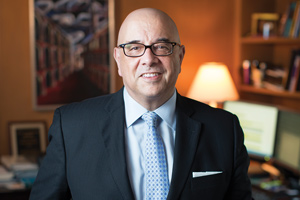Greetings From Northwestern Engineering
A message from Dean Ottino

How do we tell the story of Northwestern Engineering? Communicating our core values in this magazine is a balance between the big picture and the smallest details, between aesthetics and reader usability, and between stories that will inform and stories that will delight.
Putting it together is a complex design project. Twice a year, my team and I get together and discuss how to best tell our story. We have to balance a multitude of objectives and constituencies: our goals at the school level range from the lofty (conducting research that will help solve global problems and uncover new frontiers) to the personal (making sure each student is prepped for lifelong success). Our audiences spread from our alumni and friends to peer schools and the general public. After all the iterations are finished, the magazine should tell the story of the innovation that is core to the DNA of Northwestern Engineering.
In this issue we have assembled a broad picture of staying power and long bets, of what’s happening now and what’s looming on the horizon. We show the value of large interdisciplinary teams and of designing an environment for the personal growth of our most valuable asset: our students.
Our cover highlights the work of Ed Colgate and Michael Peshkin, two professors who have become world leaders in the field of haptics, a feedback technology that allows users to interact with the digital world through touch. They are among the most successful entrepreneurs in our school, having successfully launched a number of ventures. Their latest startup, Tanvas, aims to change Photograph by Chris Strongthe way that we use our smartphones and other electronic devices by heightening the sense of touch. They are also part of our broad robotics team that is pushing the boundaries between robotics and biology.
In this issue we have assembled a broad picture of staying power and long bets, of what’s happening now and what’s looming on the horizon. We show the value of large interdisciplinary teams and of designing an environment for the personal growth of our most valuable asset: our students.
An example of tremendous staying power is the recent success of Naurex, a startup company based on the research of Joe Moskal. Naurex was recently acquired by Allergan, which will continue development of two novel antidepressants. Joe has been working on this research for a remarkable 29 years, and we are tremendously proud of this well-deserved success.
Highlighting the power of large interdisciplinary partnerships, including many departments and other institutions, we focus on one of the greatest practical problems of our time: the search for better batteries. Our faculty are making contributions to new battery technologies that could fundamentally change our transportation and electronics industries.
Lastly, a focus on innovation in education. We get four years (sometimes five, with co-op or internships) and a limited number of action points to design the education of our students and make sure that, when they graduate, they emerge with the best first draft of themselves. This issue features our Office of Personal Development, which is focused on personal growth. We welcome exceptionally high caliber students to Northwestern Engineering, and this is one of many efforts to ensure that we provide a supportive environment that prepares our students to leave here and set the world on fire with their ideas.
As always, I welcome your feedback.
JULIO M. OTTINO
Dean, McCormick School of Engineering and Applied Science
